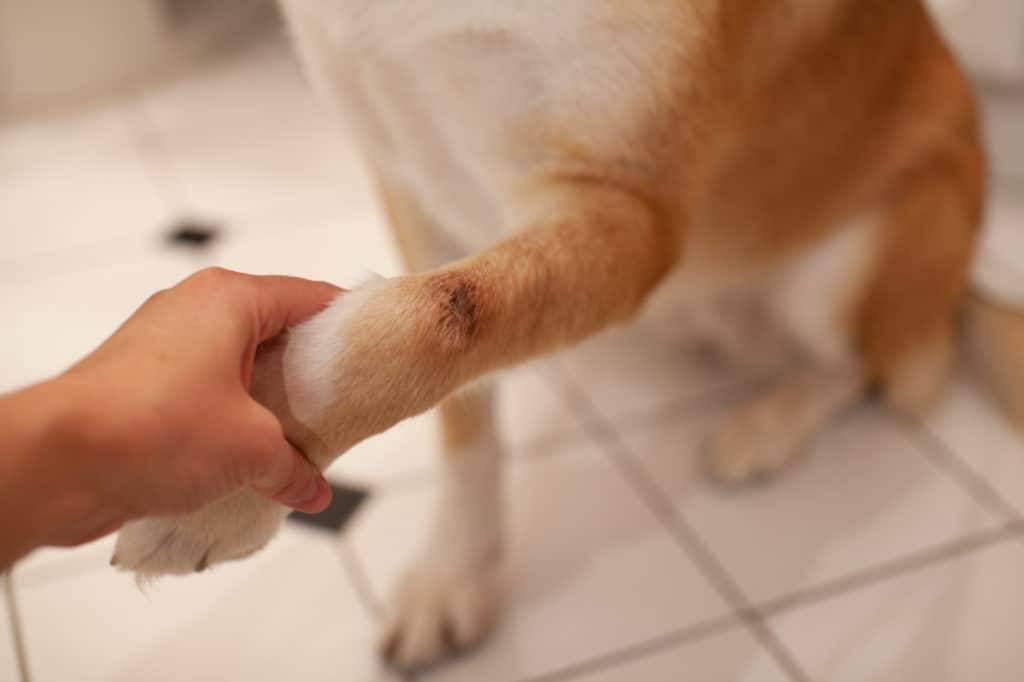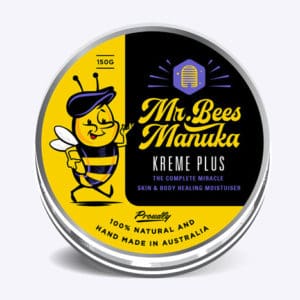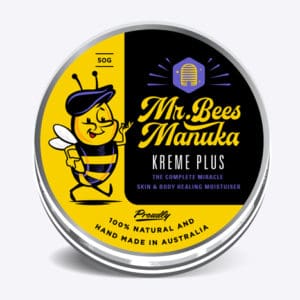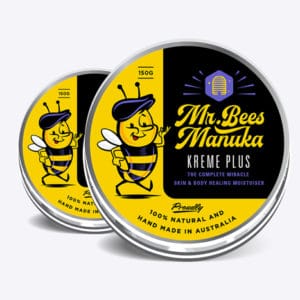As a dog owner, it’s only natural to want the best for your four-legged friend, especially when it comes to keeping their skin healthy and itch-free. And while there are many products on the market that claim to do just that, not all solutions are created equal.
Enter the sweet and sticky world of honey—a natural, centuries-old remedy with remarkable benefits for your dog’s skin.
In this blog post, we’ll delve into the reasons why honey deserves a place in your canine care arsenal, and how it can help soothe and heal your dog’s skin like no other. So, grab a spoonful of honey, and let’s explore the remarkable world of this golden elixir for the well-being of your furry friend!

Reasons Why Honey Is Good For Dogs Skin
Good for Hot Spots On Skin
Hot spots are a common skin issue in dogs characterized by red, irritated, and inflamed areas (dermatitis) that can cause significant discomfort. When it comes to treating hot spots, honey may provide a natural and effective solution. Here’s why:
Antibacterial properties: Honey has natural antibacterial properties, primarily due to its high sugar content and low water content, which inhibit the growth of harmful bacteria. This helps prevent infection and can promote healing in hot spots.
Anti-inflammatory properties: Honey contains several enzymes and bioactive compounds that can help reduce inflammation. By reducing inflammation, honey can help alleviate the pain and itchiness associated with hot spots, providing relief for your furry friend.
Wound healing: Honey has been used as a wound dressing for centuries, thanks to its ability to promote healing. Research has shown that honey can increase the rate of tissue regeneration and even reduce scarring. This makes it an excellent option for treating hot spots, which can sometimes lead to hair loss and scarring.
Natural moisturizer: Honey is a natural humectant, which means it helps retain moisture. By keeping the skin hydrated, honey can help prevent further irritation and create a more comfortable environment for the hot spot to heal.
Protective barrier: When applied to a hot spot, honey can create a protective barrier that helps keep dirt, debris, and other irritants away from the sensitive area. This reduces the likelihood of further irritation or infection and encourages the healing process.
Always remember to consult with your veterinarian before applying honey to your dog’s hot spots, as there may be underlying medical conditions that require additional treatment. It is also essential to use raw, unprocessed honey for the best results, as processed honey may have reduced antibacterial and healing properties.
-
Kreme Plus 150gm$37.00
Good for allergies on Skin
Honey can be a beneficial addition to your dog’s skincare routine, particularly when it comes to addressing allergies that affect their skin. Allergies in dogs can manifest as itching, redness, and inflammation, often leading to discomfort and the development of secondary infections. Here’s how honey can help alleviate allergy-related skin issues in dogs:
Anti-inflammatory properties: Honey is rich in enzymes, antioxidants, and bioactive compounds that possess anti-inflammatory properties. These ingredients are used to slow down irritation, swelling, and allergic reaction associated with skin allergies, providing relief for your dog.
Antibacterial and antifungal properties: Allergies often weaken the skin barrier, making it susceptible to bacterial and fungal infections. Honey’s natural antibacterial and antifungal properties can help prevent and treat these secondary infections, promoting overall skin health.
Immune system support: Some studies suggest that feeding local, raw honey to dogs can help reduce pollen allergies. The theory is that small amounts of pollen in the honey expose the dog’s immune system to the allergens, promoting a gradual tolerance to the allergens over time. While more research is needed to confirm these findings, incorporating honey into your dog’s diet may help manage some allergy symptoms.
Natural moisturizer: Honey is a natural humectant, meaning it is a excellent barrier cream. By keeping your dog’s skin hydrated, honey can help maintain the skin’s natural barrier and reduce the likelihood of allergen penetration and irritation.
Soothing properties: Honey is gentle and soothing, making it an ideal topical treatment for dogs with sensitive, allergy-prone skin. When applied topically, honey can provide relief from itching and irritation while promoting healing.
Before using honey as part of your dog’s allergy management plan, consult your veterinarian to ensure it’s appropriate for your pet’s specific needs. Keep in mind that honey should be used as a complementary treatment alongside other veterinarian-recommended measures to control allergies in dogs. Additionally, always choose raw, unprocessed honey for optimal benefits, and be cautious when using honey on open wounds or broken skin, as it can attract insects and lead to further irritation.

Good for Dogs Paws
Honey can offer several benefits for your dog’s paws, particularly when they are dry, cracked, or irritated. Here’s how honey can help improve the health and comfort of your dog’s paws:
Moisturizing properties: Honey is a natural humectant, meaning it attracts and retains moisture. Applying honey to your dog’s dry and cracked paws can help rehydrate the skin, improving its overall health and elasticity.
Soothing and healing: Honey’s soothing properties can provide relief for irritated or inflamed paw pads. Additionally, honey has been shown to promote wound healing and tissue regeneration, making it an excellent option for treating minor cuts or abrasions on your dog’s paws.
Antibacterial and antifungal properties: Honey’s natural antibacterial and antifungal properties can help protect your dog’s paws from infection. This is particularly helpful if your dog has been walking on surfaces that may harbor harmful bacteria or fungi.
Anti-inflammatory properties: The enzymes, antioxidants, and bioactive compounds in honey can help reduce inflammation, alleviating discomfort associated with swollen or irritated paw pads.
Protective barrier: Applying honey to your dog’s paws can create a protective barrier that guards against dirt, debris, and other irritants. This can be especially helpful if your dog has a tendency to lick or chew their paws due to allergies or other sensitivities.
When using honey on your dog’s paws, always choose raw, unprocessed honey for the best results. It’s essential to consult your veterinarian before applying honey to your dog’s paws, especially if they have an existing medical condition or open wounds. After applying honey, consider using dog booties or socks to prevent your dog from licking the honey off their paws or tracking it around your home.
PLEASE NOTE: We have a product which is a barrier cream which is great for Dogs Paws called Kreme Plus (See Below)
-
Kreme Plus 50gm$22.00
Dogs Wounds
Honey has been used as a wound treatment for centuries, thanks to its numerous beneficial properties that can aid in the healing process. Here’s how honey can be beneficial for your dog’s wounds:
Antibacterial properties: Honey has natural antibacterial properties, primarily due to its high sugar content, low water content, and presence of hydrogen peroxide. These factors help inhibit the growth of harmful bacteria, reducing the risk of infection and promoting a faster healing process.
Anti-inflammatory properties: Honey contains enzymes, antioxidants, and bioactive compounds that can help reduce inflammation. By minimizing inflammation around the wound, honey can alleviate pain and discomfort for your dog, as well as promote faster healing.
Wound debridement: Honey can help with the debridement of wounds, which is the removal of dead, damaged, or infected tissue. The enzyme glucose oxidase, present in honey, produces hydrogen peroxide, which aids in breaking down the dead tissue and cleansing the wound.
Moist wound healing environment: Honey maintains a moist environment, which is conducive to the healing of wounds. A moist environment can promote cell growth and tissue regeneration, ultimately leading to faster healing and reduced scarring.
Protective barrier: When applied to a wound, honey can create a protective barrier that keeps dirt, debris, and other contaminants away from the wound. This can reduce the likelihood of further irritation or infection and encourage the healing process.

Good For Dogs Noses
Honey can provide several benefits for your dog’s nose, particularly when it comes to soothing and healing dry, cracked, or irritated nasal skin. Here’s how honey can help improve the health and comfort of your dog’s nose:
Moisturizing properties: Honey is a natural humectant, which means it attracts and retains moisture. Applying honey to your dog’s dry and cracked nose can help rehydrate the skin, improving its overall health and elasticity.
Soothing and healing: Honey’s soothing properties can provide relief for irritated or inflamed nasal skin. Furthermore, honey has been shown to promote wound healing and tissue regeneration, making it an excellent option for treating minor abrasions or cracks on your dog’s nose.
-
Product on saleKreme Plus 150gm Duo PackOriginal price was: $74.00.$65.00Current price is: $65.00.
Why You Should Use Honey And Beeswax Within A Cream For Dogs Skin?
Using honey and beeswax in a cream for your dog’s skin can provide a range of benefits, making it an ideal natural option for maintaining and improving your pet’s skin health. Here’s why you should consider using a honey and beeswax-based cream for your dog’s skin:
Honey benefits:
Antibacterial properties: Honey has natural antibacterial properties that can help protect your dog’s skin from infection, particularly in cases of minor cuts, abrasions, or skin irritations.
Anti-inflammatory properties: Honey contains enzymes, antioxidants, and bioactive compounds that can help reduce inflammation, providing relief for skin irritations, redness, and itchiness.
Wound healing: Honey promotes wound healing and tissue regeneration, making it a valuable ingredient for treating minor skin injuries or irritated skin conditions.
Natural moisturizer: As a natural humectant, honey helps to maintain skin moisture, keeping your dog’s skin hydrated and healthy.
Beeswax benefits:
Emollient properties: Beeswax is a natural emollient, meaning it softens and soothes the skin. It creates a long-lasting protective barrier that helps to lock in moisture, making it particularly beneficial for dry or chapped skin.
Protective barrier: Beeswax forms a protective barrier on the skin, shielding it from environmental irritants and potential allergens. This barrier helps to reduce the likelihood of irritation and inflammation.
Anti-inflammatory properties: Like honey, beeswax also possesses anti-inflammatory properties, which can slow down redness and swelling with various skin conditions.
Antimicrobial properties: Beeswax has mild antimicrobial properties, which can help to keep harmful bacteria and fungi at bay, reducing the risk of infection.
Combining honey and beeswax in a cream creates a synergistic effect that amplifies their individual benefits, providing a gentle, effective, and natural solution for your dog’s skin health.



